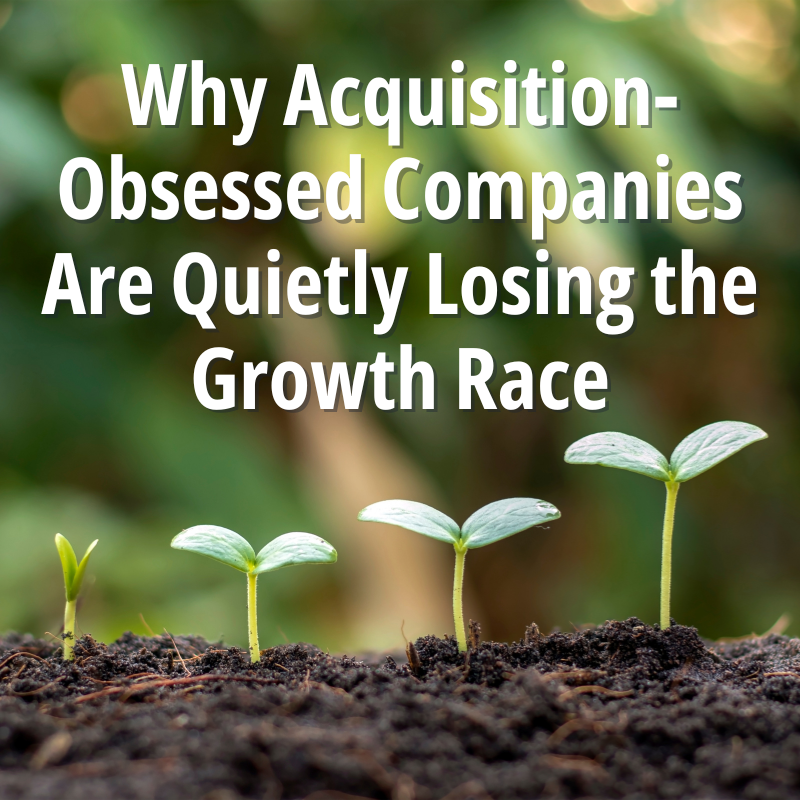By: Alan Gonsenhauser, CMO Coach and Founder & CEO, Demand Revenue, LLC
Among companies in today's saturated, acquisition-obsessed market, there's an underlying truth few can see or want to admit:
When it comes to financial results, quarterly earnings, even valuation spikes—they're all rear-view mirror indicators.
The companies that will dominate their markets in the next decade aren't the ones that simply stack up new logos or outspend their competitors. They're the ones who rewire their organizations around a singular, strategic question:
Are we focused on the right customers and giving them an experience they'd call remarkable?
Because customer acquisition alone isn't enough anymore, it's not even close.
The dominant companies won't just chase the short-term wins; they'll focus on building loyalty-driven customer ecosystems that last. Company growth isn't merely a series of transactions; it's a compounding asset built through customer alignment, experience, and trust.
Are You Attracting the Right Customers to Your Organization?
Everyone talks about lead generation and grabbing market share, but most companies still fail to understand and adequately define their Ideal Customer Profile (ICP).
When ICP alignment slips, the early numbers may still look good, but churn is already starting to take hold. New partnerships may form, sales decks may fill, and revenue charts might spike. Still, cracks begin to widen beneath the surface due to misaligned customers, fragile relationships, and slipping revenue streams. Growth today can hide tomorrow's churn.
Over time, those churn rates start rising before most companies even notice.
- Expansion opportunities shrink.
- Support costs balloon.
- Marketing ROI erodes.
Strategic company growth begins, not ends, with acquisition. Landing the wrong customers almost guarantees downstream attrition.
Future-facing company leaders are asking:
Are we bringing in customers who will stay, grow, and advocate for us, or are we mortgaging tomorrow to celebrate today?
Winning organizations do more than define an ICP once during a strategy retreat. They live it daily, aligning marketing messaging, sales targeting, product roadmaps, and customer success initiatives to serve the right buyers.
Clarity of focus on the customer ICP doesn't restrict opportunity. It amplifies it, turning every marketing dollar and sales cycle into a compounding investment, rather than a coin toss.
The Real Competitive Advantage: A Remarkable Customer Experience
What once differentiated brands — price, features, and even speed to market — has become table stakes today.
Today, a company's competitive advantage is built on something more challenging to replicate and harder to fake: a remarkable customer experience.
The correlation between excellent customer experience and business outcomes isn't just anecdotal. It's structural:
- Higher retention rates that keep valuable customers in your ecosystem
- Greater net revenue retention (NRR) as customers expand their relationship with you
- Increased customer-driven referrals that bring in pre-qualified prospects
- Expanded customer lifetime value (CLTV) that compounds over the relationship
- Reduced acquisition cost through authentic brand advocacy from satisfied customers
When customers feel genuinely understood, supported, and valued, they are more likely to stay with the brand and become loyal to it. They expand their investment, advocate for your brand, and protect you from commoditization.
Customer experience strategy isn't about adding decorative moments of delight. It's about engineering the entire journey to exceed expectations at every critical point, from your first touch with the company to long-term renewal.
In today's hyper-competitive market, where deal cycles are stretching and customer acquisition costs (CAC) are soaring, experience-driven loyalty isn't optional. It's survival.
Companies that operationalize experience, with NPS tracking and cross-functional actions to continuously improve the score, onboarding optimization, value realization roadmaps, and customer health monitoring, aren't just building goodwill; they're also driving long-term business growth and profitability.
They're building unbreakable, revenue-generating relationships.
Rear-View Metrics Won't Drive Future Company Success
Revenue growth, profit margins, and even enterprise valuations all reflect what you've already done, not what you're positioned to do next. Managing by rear-view metrics locks you into yesterday's momentum instead of building tomorrow's advantage.
The accurate indicators of future customer growth live in the following forward-facing metrics:
- Gross Revenue Retention (GRR) and Net Revenue Retention (NRR)
- Earned Growth (Net Revenue Retention + new business from customer referrals)
- Customer Satisfaction (e.g. Net Promoter Score) and Advocacy Metrics
- Brand Reputation Metrics tied to consideration shortlists and win/loss ratios
These aren't "soft" measures but predictive financial indicators disguised as customer insights.
Companies that shift executive reporting to highlight NRR, customer health scores, and expansion potential don't just measure differently; they manage differently. They rewire incentives. They pull cross-functional teams into tighter alignment. They make customer-centricity a part of how the company operates.
The companies leading the customer-centric shift aren't just tracking customer outcomes; they're using them to engineer financial predictability.
How Chasing Short-Term Wins Can Cost You Long-Term Market Leadership
Demand generation teams face relentless pressure to keep results climbing. Quarter after quarter, every lead has to defend its worth.
The unintended consequence is harder to ignore: an addiction to short-term thinking that often quietly undermines long-term growth.
- Chasing volume over strategic fit in lead generation programs.
- Prioritizing new logo acquisition over expanding loyal customers.
- Rewarding fast sales deal closes over building lasting relationships.
Meanwhile, sustainable revenue growth and customer expansion are sometimes sacrificed to meet quarterly targets.
The companies outperforming the market aren't obsessed with quarterly numbers; they build stronger customer ecosystems year after year.
- They don't just land deals; they expand the customer relationships.
- They don't just onboard customers; they engineer value realization across the entire customer lifecycle.
- They don't just reward hunters; they fuel loyalty and expansion with the same intensity.
Long-term growth isn't a buzzword. It's a board-level directive, and it demands company leadership willing to say:
"We're not here to win Q2. We're here to own the next decade."
Brand Reputation: The Quiet Force Behind Win Rates
In high-consideration B2B purchases, brand isn't a vanity play. It's a multiplier.
A strong company brand doesn't just boost awareness; it also builds loyalty. It shortens sales cycles, raises win rates, and earns you a seat at tables you might not have reached otherwise.
Buyers build their shortlists long before they ever engage with sales. If you aren't on the mental shortlist, you're invisible, no matter how strong your SDR cadences are.
Companies with strong reputations see:
- More frequent inclusion on high-value shortlists.
- Greater pricing power with less discount pressure.
- Faster deal cycles and higher close rates.
- Higher customer retention, expansion, and Net Revenue Retention (NRR) post-purchase.
And it doesn't stop at acquisition. A trusted brand continues influencing renewal decisions and expansion opportunities long after the ink dries.
Brand reputation isn't only about the frequency of advertising. It's about the experiences, stories, and signals that live in the market, whether you're aware of them or not.
In uncertain markets, brand equity becomes pipeline insurance.
Strong brands don't just win business; they also build loyalty. They set the terms of engagement before the competition even gets the chance to be heard.
Brand strength today is pipeline velocity tomorrow.
Ignore it at your peril.
Only 10% of Companies Are Building True Customer-Led Growth
Fred Reichheld, father of the Net Promoter Score (NPS), found something sobering in his latest research:
Only 10% of companies are truly delivering a customer-led growth model that drives sustainable performance.
The other 90%?
- They run surveys.
- They hold customer journey workshops.
- They talk about "customer-centricity" in board meetings.
But when it comes to operational execution, defining ICPs, aligning marketing, sales, and product around real customer needs, and measuring loyalty-driven revenue impact, they fall short.
Talking about customer-led growth is easy.
Building a business model around it is rare.
It requires:
- Ruthless clarity on the Ideal Customer Profile (ICP) and core value delivery.
- Relentless engineering of customer experience across the entire lifecycle.
- Organizational alignment around the customer, starting at the CEO level.
- Strategic patience to let loyalty, expansion, and compounding Net Revenue Retention (NRR) build over time.
Companies that succeed here treat loyalty as a core asset, not a byproduct of happiness.
They understand that customer-led growth isn't just a good business strategy:
It's financial risk management.
It's how you future-proof revenue in a world where acquisition costs are spiraling and buyer skepticism is rising.
Conclusion: Growth Won't Be Bought. It Will Be Earned.
The next decade won't be won by those who acquire the most customers at the lowest cost.
It will be won by those who:
- Attract customers with a strong strategic fit and long-term potential.
- Engineer customer experiences that drive loyalty, expansion, and advocacy.
- Operationalize a customer-led growth model across marketing, sales, product, finance, and customer success teams.
- Measure loyalty-driven growth indicators like Net Revenue Retention (NRR), Earned Growth, Customer Lifetime Value, and expansion rates.
You can chase company-wide short-term wins and hope they add up over time. Or you can align around the customers who will build your future with you.
One path drains resources chasing short-term wins. The other compounds revenue and customer loyalty over time.
The real choice isn't between growth and stagnation, it's between bought growth and earned growth.
#customerledgrowth #CX #CustomerExperience #CMO #Lifetimevalue #CEO
About the Author: Alan Gonsenhauser, an 11-time CMO and 3-time P&L General Manager, is a CMO Coach and Interim CMO who has worked in Marketing, Sales, Finance, and Operations. He has mentored over 150 CMOs at many of the world’s best-known companies, using models and frameworks that scaled their firms’ marketing operations and growth.
Book Your 15-Minute Strategy Call With Alan here.
See more from Alan at www.demandrevenue.com/

